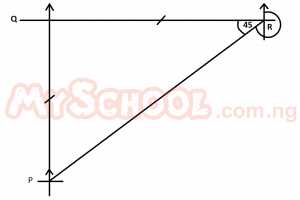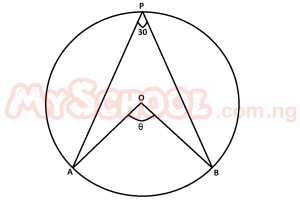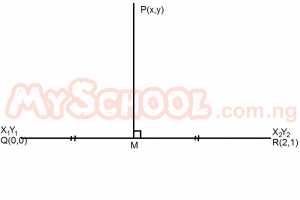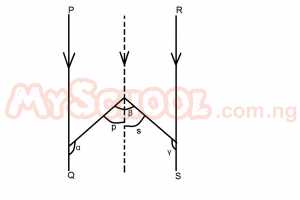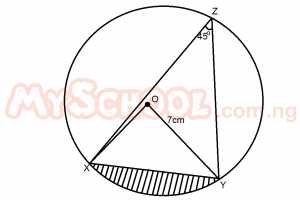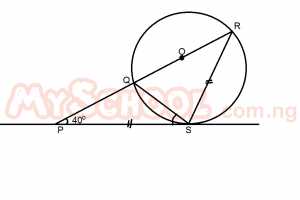Year :
2003
Title :
Mathematics (Core)
Exam :
JAMB Exam
Paper 1 | Objectives
31 - 40 of 45 Questions
| # | Question | Ans |
|---|---|---|
| 31. |
If \(^{n}P_{3} - 6(^{n}C_{4}) = 0\), find the value of n. A. 5 B. 6 C. 7 D. 8 Detailed Solution\(^{n}P_3 - 6(^{n}C_{4})=0\\\frac{n!}{(n-3)!}-6\left( \frac{n!}{(n-4)!4!}\right)=0\\\frac{n!}{(n-3)!}=6\left(\frac{n!}{(n-4)!4!}\right)\\n!((n-4)!4!)=6n!(n-3)!\\((n-4)!4!)=6(n-3)!\\\frac{(n-4)!}{(n-3)!}=\frac{6}{4!}\\\frac{(n-4)!}{(n-3)(n-4)!}=\frac{6}{4 \times 3\times 2\times 1}\\\frac{1}{(n-3)}=]\frac{1}{4}\\n-3=4\\n=4+3\\n=7\) |
|
| 32. |
Find the number of committees of three that can be formed consisting of two men and one woman from four men and three women A. 3 B. 6 C. 18 D. 24 Detailed Solution\(^{4}C_2 \times ^{3}C_1 = \left(\frac{4!}{(4-2)!2!}\right)\times\left(\frac{3!}{(3-1)!1!}\right)\\=\frac{4!}{2!2!}\times \frac{3!}{2!}\\=\frac{4 \times 3 \times 2!}{2 \times 1 \times 2!} \times \frac{3 \times 2!}{2!}\\=18\) |
|
| 33. |
A bag contains 5 blacks balls and 3 red balls. Two balls are picked at random without replacement. What is the probability that a black and red balls are picked? A. 15/28 B. 13/28 C. 5/14 D. 3/14 Detailed SolutionBlack balls = 5Red balls = 3/8 P(B) = 5/8, P(R) = 3/8 P( a Black and a Red) = BR + RB = (5/8) * (3/7) * (3/8) * (5/7) = (15/56) + (15/56) = 30/56 = 15/28 |
|
| 34. |
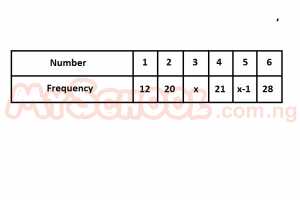 The result of tossing a fair die 120 times is summarized above. Find the value of x A. 19 B. 20 C. 21 D. 22 Detailed Solution12 + 20 + x + 21 + x-1 +28 = 1202x + 80 = 120 2x = 120 - 80 2x = 40 x = 20 |
|
| 35. |
An aeroplane flies due north from airport P to Q and then flies due east R. If Q is equidistant from P and R, find the bearing of P and R A. 90o B. 135o C. 225o D. 270o Detailed Solution
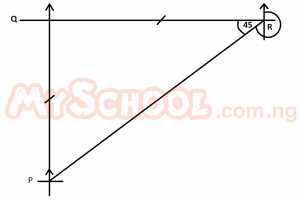 ∴ ∠PQR = 45o => The bearing of P from R = 180 + 45 = 225o |
|
| 36. |
An arc of a circle subtends an angle of 30° on the circumference of a circle of radius 21cm. Find the length of the arc. A. 11cm B. 22cm C. 44cm D. 66cm Detailed Solution
∴ θ = 60° Length of arc = \(\frac{\theta}{360}\times 2\pi r\\ =\frac{60}{360}\times 2 \times \frac{22}{7}\times \frac{21}{1}\\ =22cm\) |
|
| 37. |
Find the equation of the locus of a point P(x,y) which is equidistant from Q(0,0) and R(2,1). A. 4x + 2y = 5 B. 4x - 2y = 5 C. 2x + 2y = 5 D. 2x + y = 5 Detailed Solution
Mid point QR = \(\frac{x_2 + x_1}{2}, \frac{y_2 + y_1}{2}\) = \(\frac{2 + 0}{2}, \frac{1 + 0}{2}\) = \((1, \frac{1}{2})\) Gradient of QR = \(\frac{y_{2} - y_{1}}{x_{2} - x_{1}}\) = \(\frac{1 - 0}{2 - 0}\) = \(\frac{1}{2}\) Gradient of PM = \(\frac{-1}{\frac{1}{2}}\) = -2 Equation of PM = y - y\(_1\) = m(x-x_\(_1\)) i.e y - 1/2 = -2(x-1) 2y - 1 = -4(x-1) 2y - 1 = -4x + 4 2y + 4x = 5 |
|
| 38. |
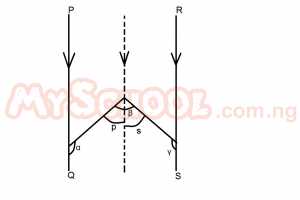 In the diagram above, PQ is parallel to RS. What is the value of α + β + γ? A. 360o B. 200o C. 180o D. 90o Detailed Solution
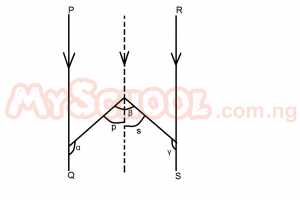 S = 180 - γ α + P = 180(Allied angles) p = 180 - α β = P + S β = 180 - α + 180 - γ β = 360 - α - γ β + α + γ = 360 |
|
| 39. |
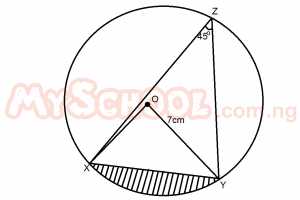 XYZ is a circle with center O and a radius 7cm. Find the area of the shaded region. A. 84cm2 B. 77cm2 C. 38cm2 D. 14cm2 Detailed Solution
θ = 90° Area of sector = θ/360 x πr2 = 90/360 x 22/7 x 7 x 7 = 77/2cm\(^2\) Area of triangle = 1/2 ab sin θ = 1/2 x 7 x 7 sin 90 = 1/2 x 7 x 7 x 1 = 49/2 cm\(^{2}\) Area of shaded region = 77/2 - 49/2 = 28/2 = 14cm\(^2\) |
|
| 40. |
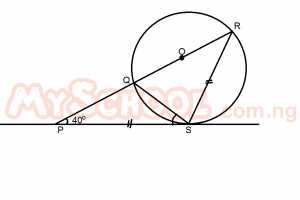 In the diagram above, PQR is a straight line and PS is a tangent to the circle QRS with /PS/ = /SR/ and ∠SPR = 40°. Find ∠PSQ A. 40o B. 30o C. 20o D. 10o Detailed Solution
∴R = 40° ∠PSQ = R (∠s in alternate segment) ∴∠PSQ = 40° |
| 31. |
If \(^{n}P_{3} - 6(^{n}C_{4}) = 0\), find the value of n. A. 5 B. 6 C. 7 D. 8 Detailed Solution\(^{n}P_3 - 6(^{n}C_{4})=0\\\frac{n!}{(n-3)!}-6\left( \frac{n!}{(n-4)!4!}\right)=0\\\frac{n!}{(n-3)!}=6\left(\frac{n!}{(n-4)!4!}\right)\\n!((n-4)!4!)=6n!(n-3)!\\((n-4)!4!)=6(n-3)!\\\frac{(n-4)!}{(n-3)!}=\frac{6}{4!}\\\frac{(n-4)!}{(n-3)(n-4)!}=\frac{6}{4 \times 3\times 2\times 1}\\\frac{1}{(n-3)}=]\frac{1}{4}\\n-3=4\\n=4+3\\n=7\) |
|
| 32. |
Find the number of committees of three that can be formed consisting of two men and one woman from four men and three women A. 3 B. 6 C. 18 D. 24 Detailed Solution\(^{4}C_2 \times ^{3}C_1 = \left(\frac{4!}{(4-2)!2!}\right)\times\left(\frac{3!}{(3-1)!1!}\right)\\=\frac{4!}{2!2!}\times \frac{3!}{2!}\\=\frac{4 \times 3 \times 2!}{2 \times 1 \times 2!} \times \frac{3 \times 2!}{2!}\\=18\) |
|
| 33. |
A bag contains 5 blacks balls and 3 red balls. Two balls are picked at random without replacement. What is the probability that a black and red balls are picked? A. 15/28 B. 13/28 C. 5/14 D. 3/14 Detailed SolutionBlack balls = 5Red balls = 3/8 P(B) = 5/8, P(R) = 3/8 P( a Black and a Red) = BR + RB = (5/8) * (3/7) * (3/8) * (5/7) = (15/56) + (15/56) = 30/56 = 15/28 |
|
| 34. |
 The result of tossing a fair die 120 times is summarized above. Find the value of x A. 19 B. 20 C. 21 D. 22 Detailed Solution12 + 20 + x + 21 + x-1 +28 = 1202x + 80 = 120 2x = 120 - 80 2x = 40 x = 20 |
|
| 35. |
An aeroplane flies due north from airport P to Q and then flies due east R. If Q is equidistant from P and R, find the bearing of P and R A. 90o B. 135o C. 225o D. 270o Detailed Solution
 ∴ ∠PQR = 45o => The bearing of P from R = 180 + 45 = 225o |
| 36. |
An arc of a circle subtends an angle of 30° on the circumference of a circle of radius 21cm. Find the length of the arc. A. 11cm B. 22cm C. 44cm D. 66cm Detailed Solution
∴ θ = 60° Length of arc = \(\frac{\theta}{360}\times 2\pi r\\ =\frac{60}{360}\times 2 \times \frac{22}{7}\times \frac{21}{1}\\ =22cm\) |
|
| 37. |
Find the equation of the locus of a point P(x,y) which is equidistant from Q(0,0) and R(2,1). A. 4x + 2y = 5 B. 4x - 2y = 5 C. 2x + 2y = 5 D. 2x + y = 5 Detailed Solution
Mid point QR = \(\frac{x_2 + x_1}{2}, \frac{y_2 + y_1}{2}\) = \(\frac{2 + 0}{2}, \frac{1 + 0}{2}\) = \((1, \frac{1}{2})\) Gradient of QR = \(\frac{y_{2} - y_{1}}{x_{2} - x_{1}}\) = \(\frac{1 - 0}{2 - 0}\) = \(\frac{1}{2}\) Gradient of PM = \(\frac{-1}{\frac{1}{2}}\) = -2 Equation of PM = y - y\(_1\) = m(x-x_\(_1\)) i.e y - 1/2 = -2(x-1) 2y - 1 = -4(x-1) 2y - 1 = -4x + 4 2y + 4x = 5 |
|
| 38. |
 In the diagram above, PQ is parallel to RS. What is the value of α + β + γ? A. 360o B. 200o C. 180o D. 90o Detailed Solution
 S = 180 - γ α + P = 180(Allied angles) p = 180 - α β = P + S β = 180 - α + 180 - γ β = 360 - α - γ β + α + γ = 360 |
|
| 39. |
 XYZ is a circle with center O and a radius 7cm. Find the area of the shaded region. A. 84cm2 B. 77cm2 C. 38cm2 D. 14cm2 Detailed Solution
θ = 90° Area of sector = θ/360 x πr2 = 90/360 x 22/7 x 7 x 7 = 77/2cm\(^2\) Area of triangle = 1/2 ab sin θ = 1/2 x 7 x 7 sin 90 = 1/2 x 7 x 7 x 1 = 49/2 cm\(^{2}\) Area of shaded region = 77/2 - 49/2 = 28/2 = 14cm\(^2\) |
|
| 40. |
 In the diagram above, PQR is a straight line and PS is a tangent to the circle QRS with /PS/ = /SR/ and ∠SPR = 40°. Find ∠PSQ A. 40o B. 30o C. 20o D. 10o Detailed Solution
∴R = 40° ∠PSQ = R (∠s in alternate segment) ∴∠PSQ = 40° |
